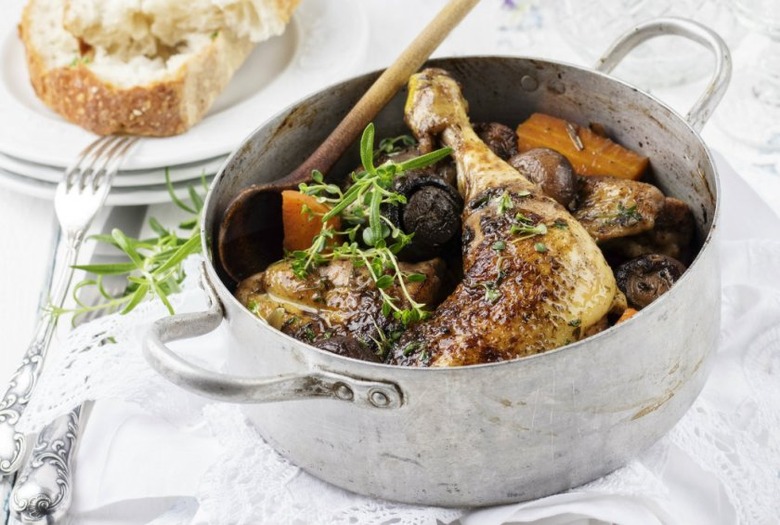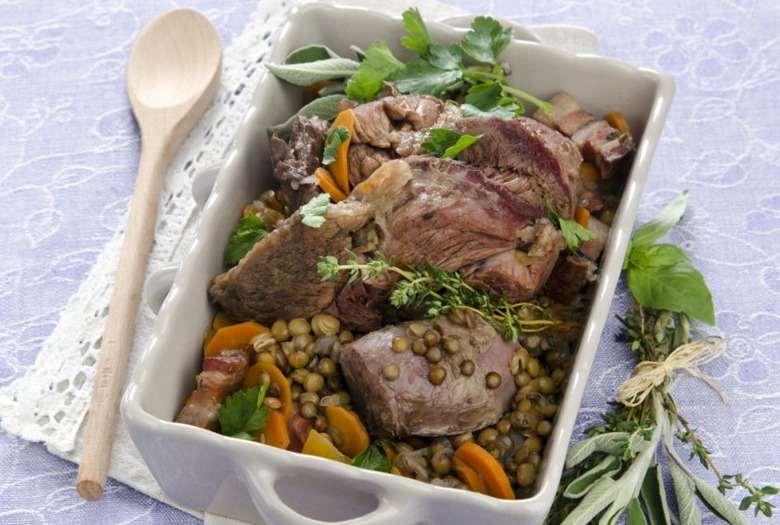Lenny Russo Emphasizes Indigenous Ingredients From America's Heartland
Lenny Russo was eating locally, sustainably, and "farm-forward" long before these buzzwords took hold of the food industry. Growing up above a deli in Hoboken, New Jersey, it almost seems like fate led Russo to a life in the food industry. Eating fresh, in-season food was part of his everyday life, and when he moved to the Midwest, Russo continued this tradition, taking an interest in local food traditions and indigenous ingredients that grow in that region.
Today, Russo owns Heartland, a restaurant in St. Paul, which prides itself on its constantly changing menu featuring locally grown, sustainable ingredients. Now, in his cookbook named after his successful restaurant, Russo is sharing some of his favorite Mid-Western inspired cuisine that is peppered with his own experiences having been raised by Italian immigrant parents, like his Potato Gnocchi made using traditional techniques and locally sourced, seasonal ingredients.
Russo's book also pays homage to his home in America's heartland with dishes, like his Braised Red Cabbage, which was made popular in the region by the long history of Central European residents settled there.
The book is an open-letter to the region Russo has called home for more than three decades, showcasing the bounty of whole ingredients, flavors, and natural beauty of the region as depicted by artist George Morrison's mixed media artwork that fills the book.
We had the opportunity to talk with Russo about his latest cookbook, what drives him to keep cooking, and the culinary traditions of America's heartland.
The Daily Meal: Can you tell us a little about what inspires your cooking in general?
Lenny Russo: I gain most of my inspiration from the ingredients. Without personifying them too much, I essentially let them speak to me. They usually tell what I should do with them.
How did that influence the recipes you chose to include in this book?
The book celebrates the farms, farmers, and larder of the greater North American Midwest, so it is completely ingredient driven.
You are known as a pioneer of the seasonal, farm-to-fork, nose-to-tail dining movements. How did you first become interested in this style of cooking that emphasizes sustainability and cooking with local ingredients?
I was born into an Italian immigrant family in Hoboken, New Jersey. I grew up eating that way. Celebrating the freshness and purity of local and regional ingredients just came naturally. I honestly don't really know how to do it in any other way, at least in a way that is able to satisfy what I seek to achieve when composing a dish.
Your food is heavily influenced by your Midwestern surroundings; can you tell us a few examples of how that rings true?
I employ classic French and Italian method and technique. Consequently, one might find a cassoulet rendition on the menu that is passed through the prism of our locale. For instance, such a recipe might utilize root vegetables and venison since that might be what is readily at hand. The same can said for a version of bouillabaisse that celebrates only freshwater fish or a pasta stuffed with local wild mushrooms.
And how do these dishes also relate to food you would find in any dining room across the U.S.?
Again, you might see some of these dishes prepared in a more classical fashion, but they are reinterpreted by us using what is locally and seasonally available.
Why do you think the Midwest's culinary scene has been in some respects ignored or overshadowed by East and West coast food scenes?
We are often thought of as flyover country that is populated by folks with bland palates even though we are the home of some of the best ingredients in the world.
Do you see that changing any time in the near future?
It has already changed. It is only for those who still harbor a skewed view and prejudicial opinion of the Midwest that it hasn't changed.
How do you hope readers will use the book?
I hope they will use it to adapt the recipes to those ingredients that they find readily available wherever they may be.
What is the ultimate takeaway for readers from this book?
Ultimately, it is a celebration of the land, the farms, the farmers and the people who have chosen to make the Midwest their home. In that respect, I hope that they will realize how magnificent this region really is.
Is there anything else you would like to share with us about the book?
I would like for people to take notice of the indigenous ingredients that existed here prior to European contact as well as those that came after. I also hope that they will appreciate the genius of George Morrison whose art work not only comprises the cover of the book but is also featured throughout it. I am very grateful to his son Briand who gave us permission to celebrate George's life in this book.
Want to try a recipe?
Chocolate Maple Roulade
At Heartland, we use maple syrup in much the same way as we do sorghum syrup. This lovely dessert pairs chocolate with maple syrup to create a mousse that we roll inside chocolate sponge cake to form a roulade. As is standard in pastry kitchens, we weigh the dry ingredients rather than measure them. — Lenny Russo
Coq Au Vin
We go through a lot of whole, free-range chicken at the restaurant, and I am always searching for ways to use the legs and thighs. Sometimes they end up in sausage or in a small plate to serve in our lounge. But other times, they inspire my version of a classic French bistro dish. Feel free to substitute dry white wine for the red, and you'll have coq au vin blanc. — Lenny Russo
Green Asparagus Soup With Celery Seed Sour Cream and Toasted Hazelnuts —
This delicate, mint-scented soup is one of the first recipes we return to when spring arrives in Minnesota each year. I have demonstrated it numerous times at local farmers markets and in front of a camera for our local television broadcast affiliates. It never fails to draw praise from those who have tried it at home.Lenny Russo
For the Green Asparagus Soup With Celery Seed Sour Cream and Toasted Hazelnuts recipe, click here.
Lentils With Smoked Pork
This is another elemental stew that makes a hearty lunch on a rainy day. Serve it in large bowls with a salad of bitter greens in light vinaigrette. Lentils are drought resistant, which make them a good crop for hot summers with sparse rainfall which we often experience here in the Upper Midwest. Our lentils, which come in various colors, sizes and flavor profiles, are from Chieftain Wild Rice Company in Spooner, Wisconsin. Because they are a pulse, or a grain legume, they lend themselves well to crop rotation since they actively fix nitrogen to the soil during the growing season. Consequently, lentils are one cover crop that can also be harvested for profit by regional farmers.
Pan Fried Rainbow Trout With Roasted Morels and Shell Pea-Mint Sauce
This colorful dish celebrates our state mushroom, with first-of-the-season peas and mint. A small amount of butter adds rich flavor, while grapeseed oil prevents the butter from burning. The bright green sauce is so delicious that I often serve it to vegans as a vibrant spring soup. Try it with any white fish. — Lenny Russo
For the Pan Fried Rainbow Trout With Roasted Morels and Shell Pea-Mint Sauce recipe, click here.
Potato Gnocchi With Chanterelles, Arugula, and Tomato
Like gnudi, gnocchi are dumplings. But potatoes are the primary ingredient instead of cheese and eggs. They are delicious when served with spinach wilted in oil with a touch of minced garlic and topped with freshly grated Parmesan cheese. This version includes chanterelles, which elevate any dish in my book. — Lenny Russo
For the Potato Gnocchi With Chanterelles, Arugula and Tomato recipe, click here.
Angela Carlos is the Cook Editor at The Daily Meal. Find her on Twitter and tweet @angelaccarlos.





